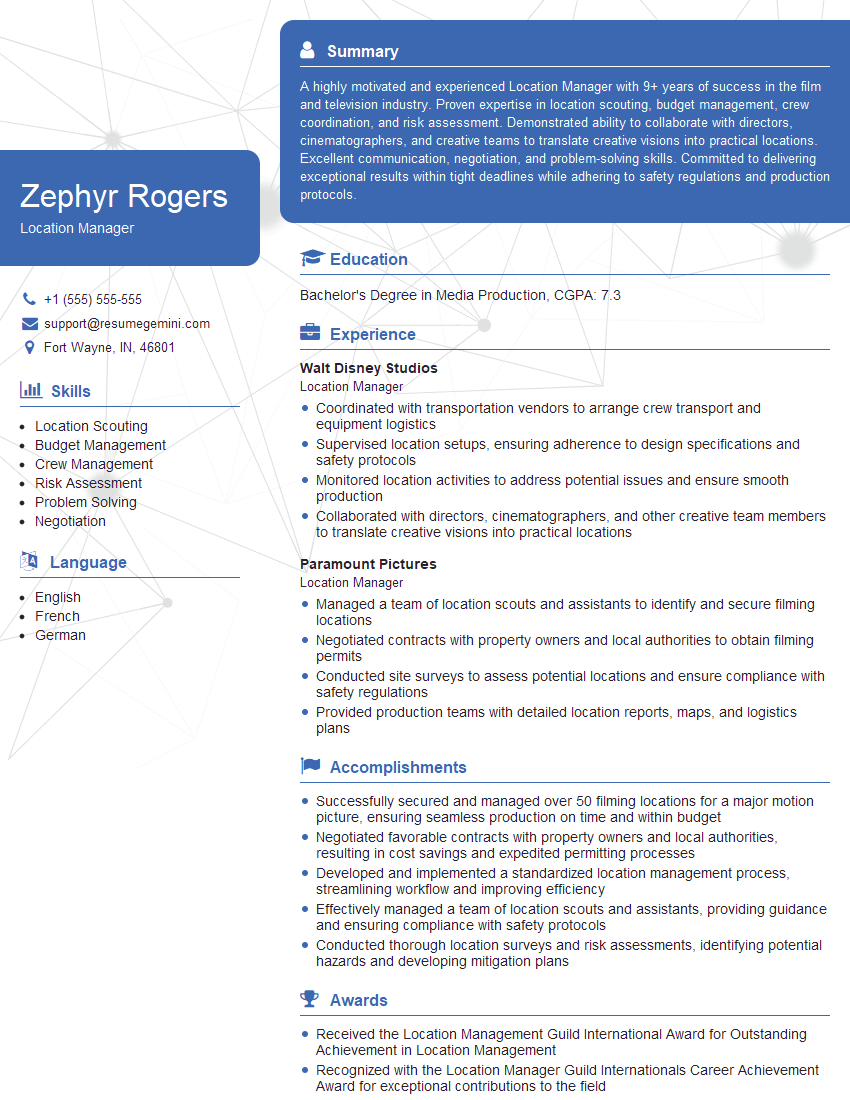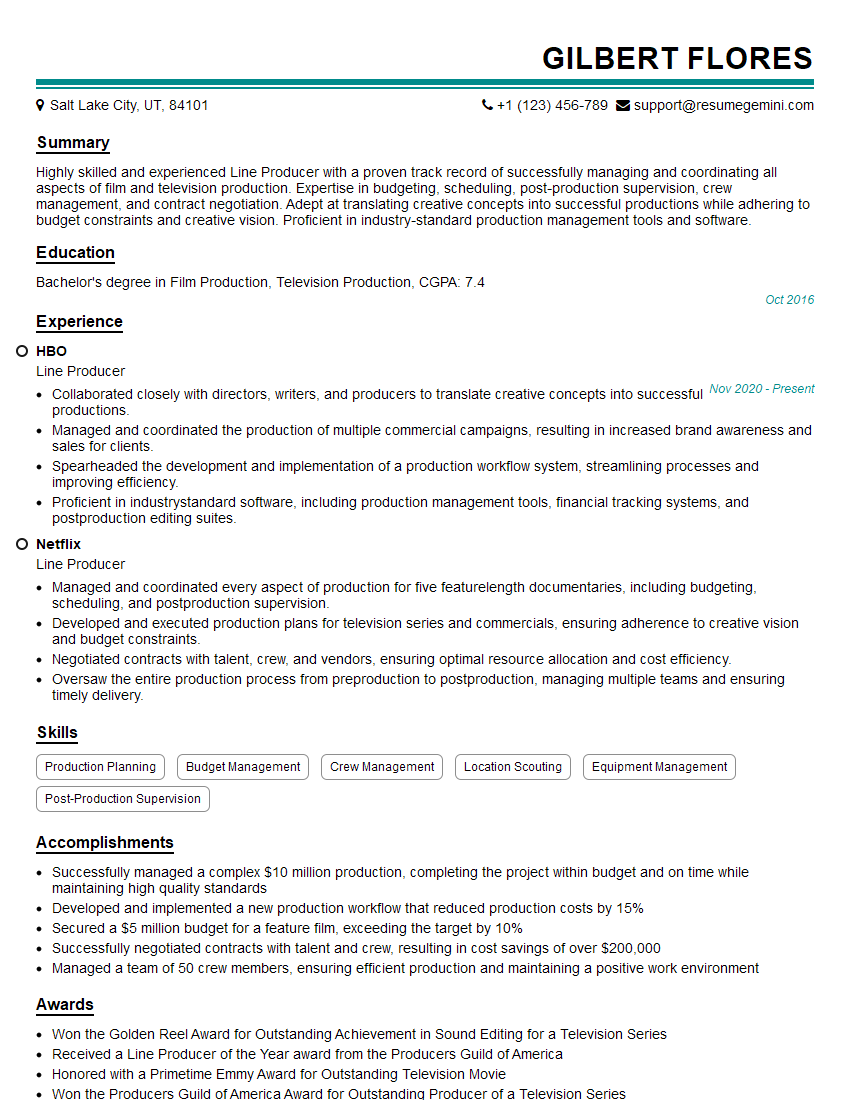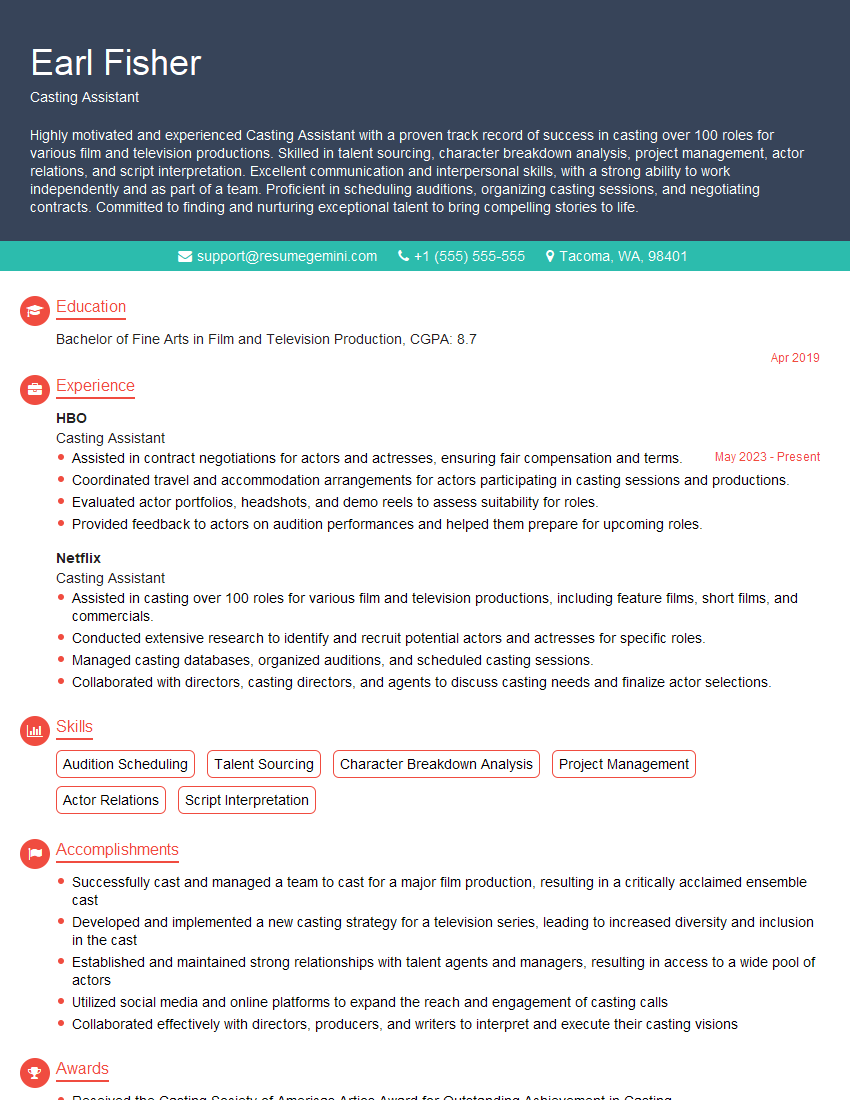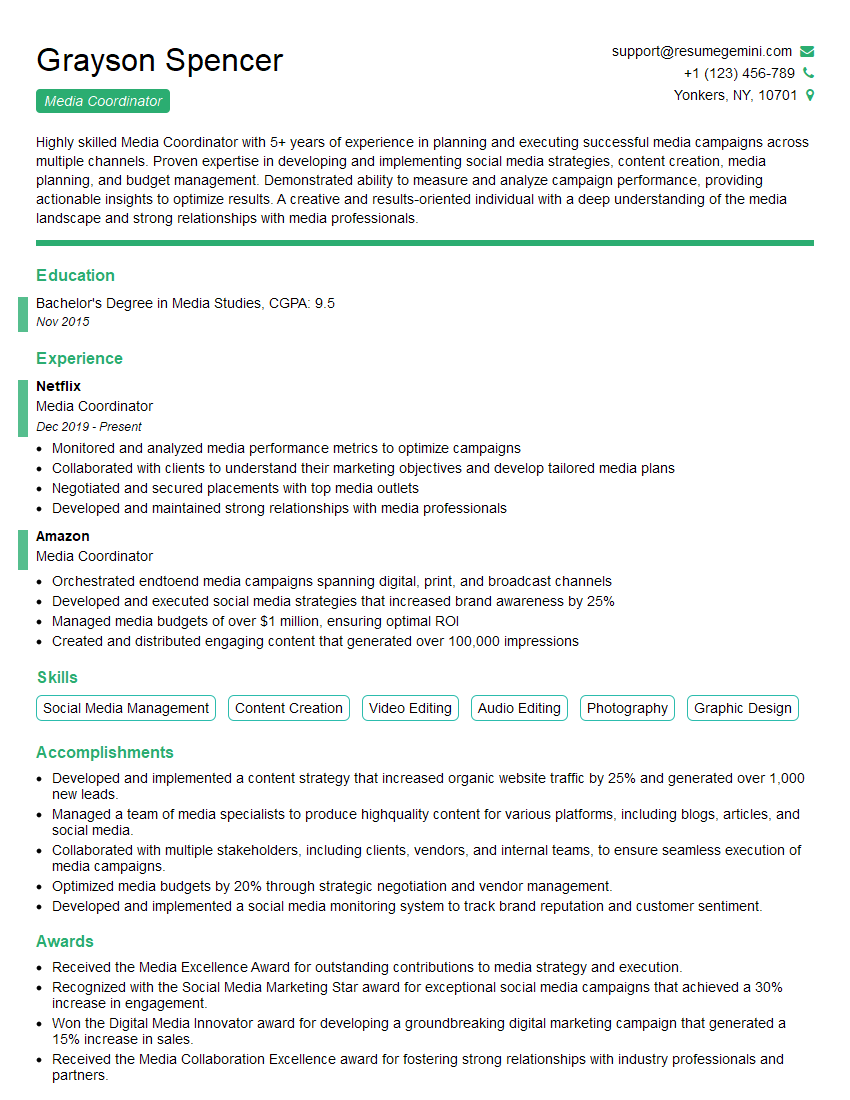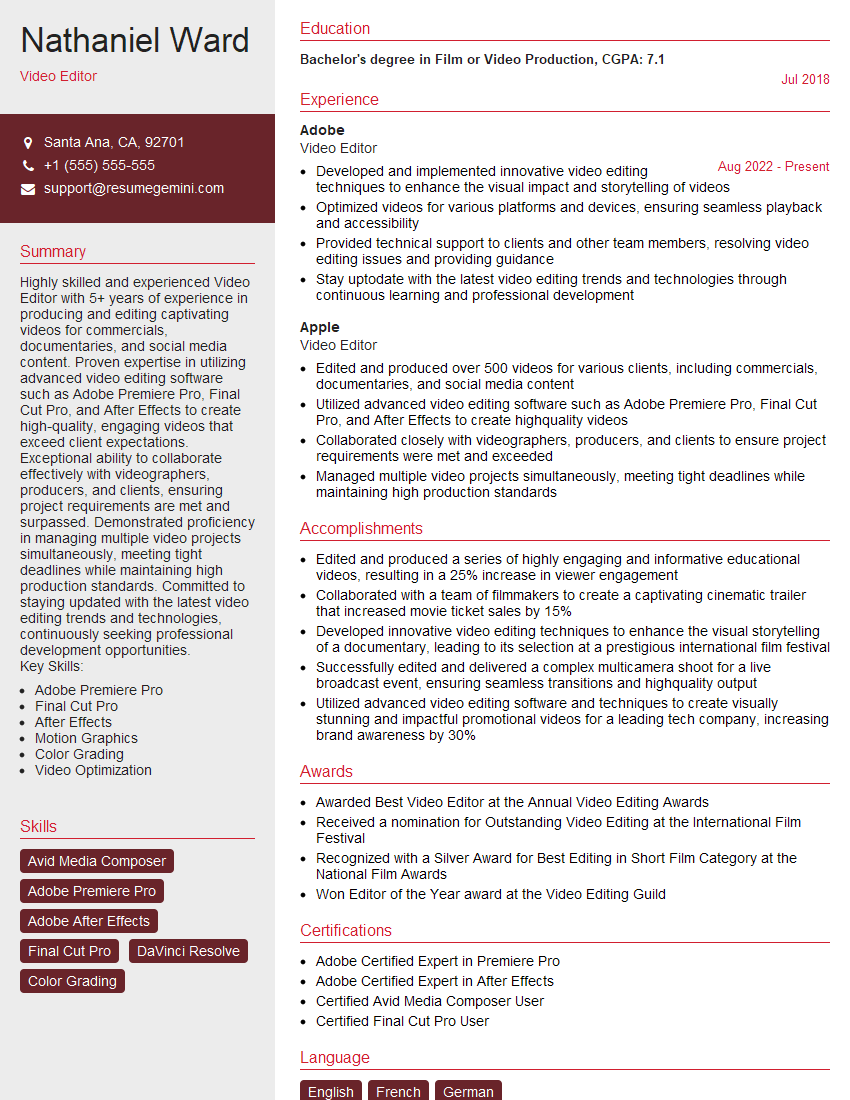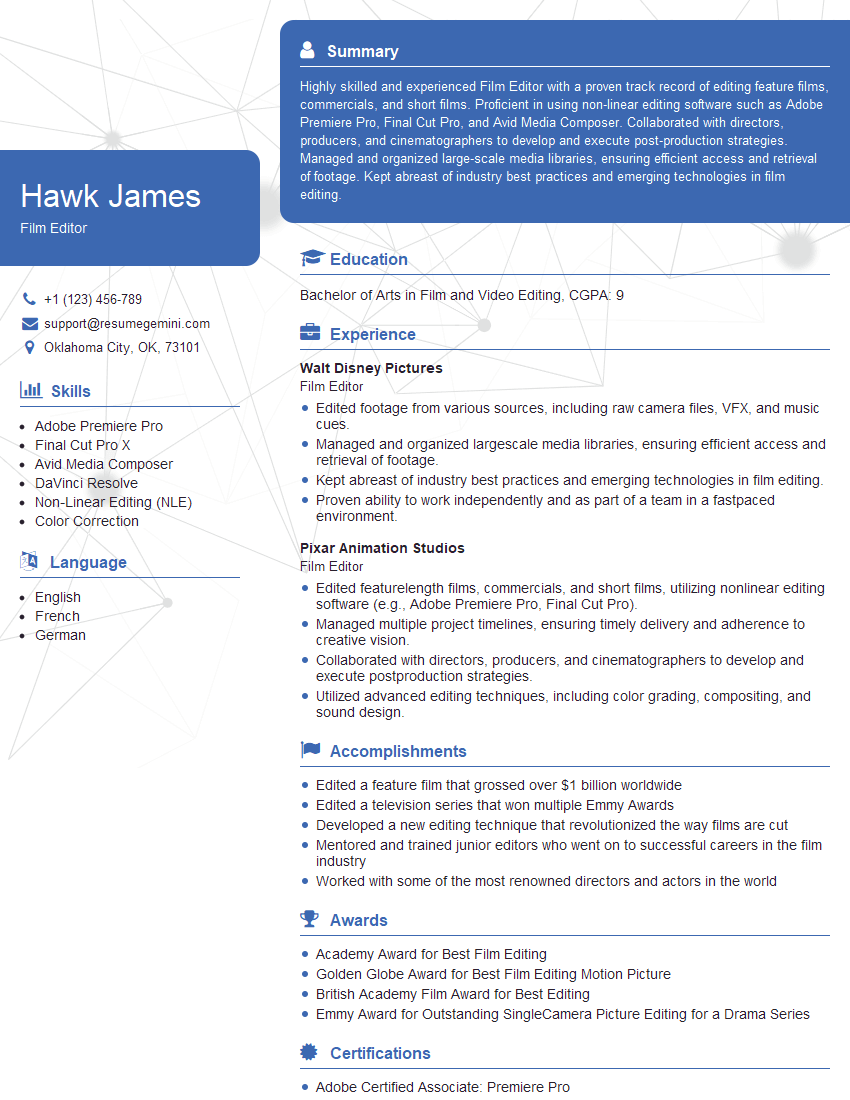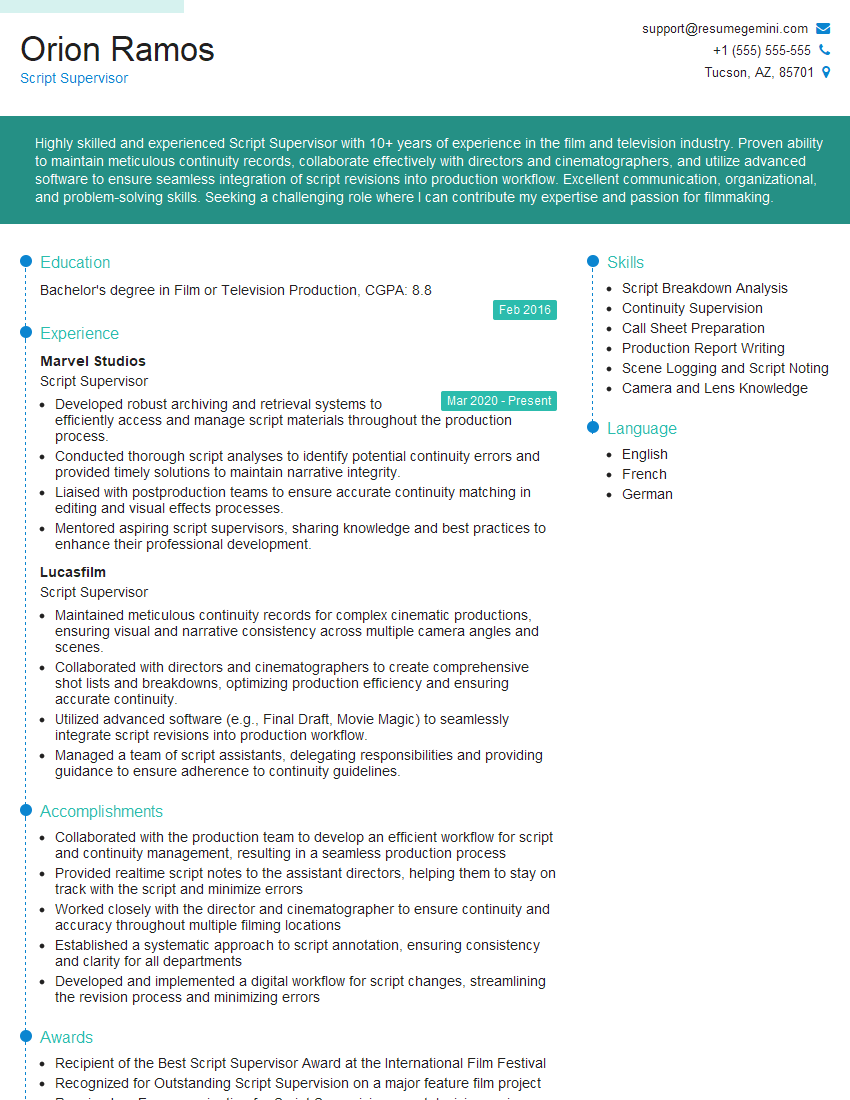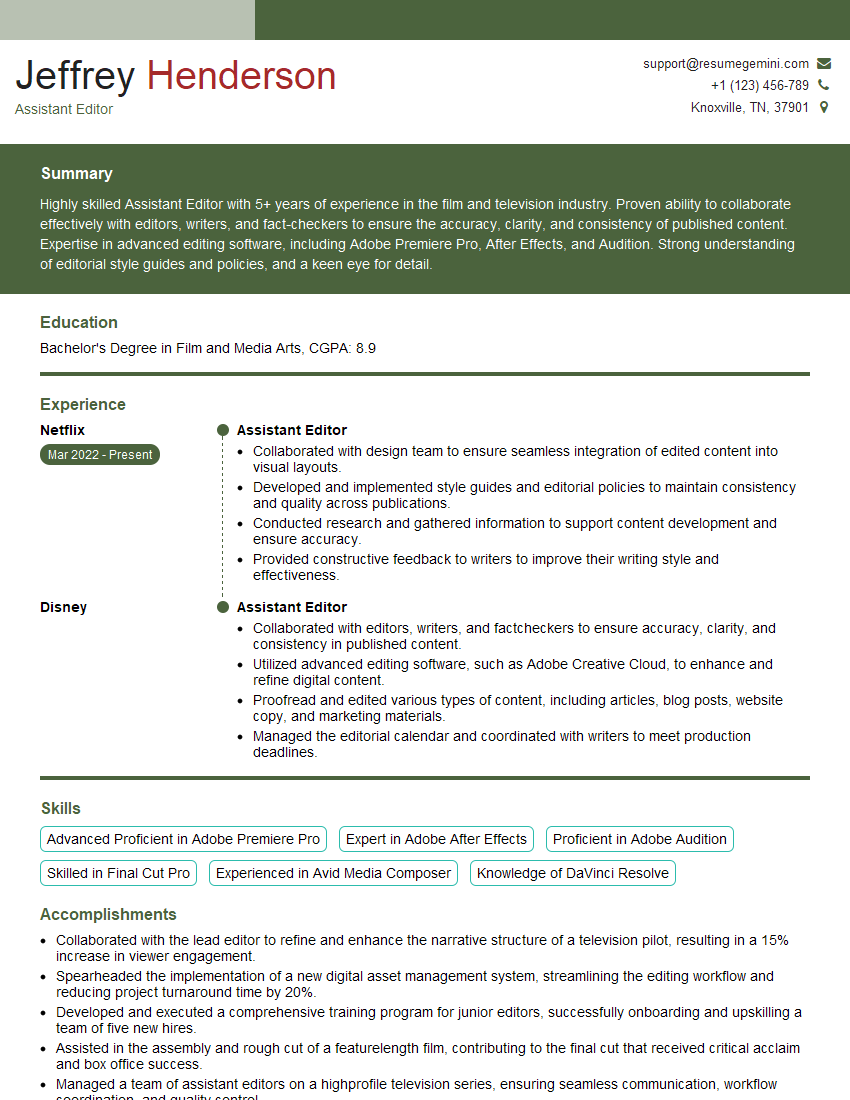Are you ready to stand out in your next interview? Understanding and preparing for Knowledge of script supervision techniques interview questions is a game-changer. In this blog, we’ve compiled key questions and expert advice to help you showcase your skills with confidence and precision. Let’s get started on your journey to acing the interview.
Questions Asked in Knowledge of script supervision techniques Interview
Q 1. Explain the role of a script supervisor in film production.
The script supervisor, often called a ‘second second assistant director’ (2nd 2nd AD) or ‘continuity,’ is a crucial role in film production. They are the guardians of continuity, ensuring that everything from dialogue and actor performances to props, costumes, and set dressing remains consistent throughout the film’s shooting process. This allows the editor to seamlessly piece together the final product. Essentially, they’re the meticulous record-keepers, meticulously tracking every detail of every shot. Imagine them as the detective of the film set, solving the puzzle of continuity before any discrepancies arise.
Q 2. Describe your experience using script supervision software.
I’ve extensively used software like StudioBinder and Movie Magic Scheduling. These programs are invaluable for managing script breakdowns, tracking changes, and maintaining detailed logs of each scene’s production. For example, in a recent project using StudioBinder, I inputted the daily call sheet, which the software then used to generate a comprehensive report showing everything from prop details to actor availability. This allowed me to swiftly identify potential continuity issues before they even surfaced on set. The ability to instantly cross-reference data—say, checking if a specific costume was used in a prior scene—saved countless hours and ensured seamless continuity.
Q 3. How do you maintain accurate continuity of props, costumes, and set dressing?
Maintaining continuity of props, costumes, and set dressing involves meticulous record-keeping and proactive communication. I utilize detailed shot lists, noting the precise state of each element in every shot. For instance, if a character is holding a coffee cup in one shot, I make detailed notes of the cup’s position, fill level, and any distinguishing marks. I then photograph these details for reference. Before each take, I conduct a thorough check, ensuring everything matches the previous shot. Any changes are immediately documented and communicated to the art department to maintain consistent visual storytelling. Think of it like a highly detailed visual checklist ensuring every element remains faithful to the story’s progression.
Q 4. How do you handle discrepancies between the script and the director’s vision?
Discrepancies between the script and the director’s vision are commonplace. My approach is one of collaborative problem-solving. First, I document the director’s changes meticulously. This usually involves creating detailed notes or adding annotations directly to my script copy, clarifying the specific deviation from the original plan. Second, I then communicate these alterations to the relevant departments – such as costume, set dressing, and the actors – ensuring everyone is on the same page. Third, I update my digital logs to reflect the changes, providing a clear audit trail for future reference. The key here is clear communication and careful documentation to ensure everyone understands the changes and maintains a consistent record.
Q 5. What methods do you use to track scene continuity and actor performances?
Tracking scene continuity and actor performances involves a multi-pronged approach. I use a combination of detailed shot lists, on-set photography, and video recordings of rehearsals and takes. For scene continuity, I carefully note camera angles, actor positions, and the overall mise-en-scène (the arrangement of elements within the scene). For actor performances, I note significant changes in emotion, physicality, or dialogue delivery. This information is cross-referenced with the script to identify any inconsistencies. Think of it as building a detailed map that shows the precise path of the storyline and the actors’ emotional journey.
Q 6. Explain your process for logging and documenting changes to the script.
My process for logging and documenting script changes is rigorous and systematic. Any alterations, whether big or small – from a minor dialogue tweak to a scene rearrangement – are logged immediately. I use a color-coded system on my script copy to highlight changes, indicating the nature of the modification (added, deleted, altered) and its source (director, writer, etc.). This annotated script is then backed up by detailed digital logs within my chosen software. These logs usually include timestamps, descriptions of the changes, and the relevant personnel involved. This detailed system ensures easy tracking and quick access to a complete history of the script’s evolution.
Q 7. How do you manage multiple cameras and takes during filming?
Managing multiple cameras and takes requires a highly organized approach. I utilize a system of clear labeling and meticulous record-keeping. Each take is numbered sequentially (e.g., Take 1, Take 2, etc.), and I note the camera used for each take (Camera A, Camera B, etc.) in my logs. Additionally, I record the director’s chosen ‘master take’ for each scene. I also document any significant differences between the takes, noting which camera angles capture specific actor performances or prop placements. I utilize timecodes to accurately identify specific moments within each take, allowing for precise reference points during the editing process. This ensures easy access to the best possible takes during post-production.
Q 8. How do you communicate effectively with the director, actors, and crew?
Effective communication is the cornerstone of script supervision. It’s about building relationships based on trust and mutual respect. With the director, it’s about proactively anticipating their needs, understanding their vision, and offering solutions, not just problems. I communicate clearly and concisely, using visual aids like annotated scripts and storyboards when needed. With actors, it’s about fostering a collaborative environment; I might gently guide them on line readings to maintain continuity, but always in a supportive way. With the crew, clear and efficient communication is key. I utilize concise notes, daily reports, and regular check-ins to ensure everyone is on the same page regarding continuity and scheduling.
For example, if an actor deviates from the script, I’d discreetly note it, and if appropriate, discuss the change with the director before it causes further continuity issues. Similarly, if a lighting change affects a previous shot, I’d communicate with the gaffer to ensure the final product remains consistent.
Q 9. Describe your experience with creating and maintaining a daily call sheet.
Creating and maintaining a daily call sheet is a crucial aspect of script supervision. It’s essentially a roadmap for the day’s shoot. My process begins with extracting key information from the production schedule, script breakdown, and shot list. I then meticulously compile details like scene numbers, shot numbers, locations, cast and crew call times, and any specific notes or requirements for each scene. I also incorporate any relevant production updates or changes made during the day. This ensures everyone on set is informed and prepared. I meticulously track any changes or additions to the call sheet and communicate them proactively to avoid confusion.
I’ve used various software solutions for this, from simple spreadsheets to dedicated production management software. Regardless of the tool, the key is clarity, accuracy, and timeliness. For instance, a recent project involved a last-minute location change; updating the call sheet promptly prevented delays and kept the crew informed.
Q 10. How do you resolve continuity issues that arise during filming?
Continuity issues are inevitable, but their impact can be minimized with proactive measures. My approach involves a multi-pronged strategy: First, thorough preparation – I meticulously review the script and storyboard before filming to identify potential pitfalls. On set, I diligently observe every detail: wardrobe, props, hair, makeup, and background elements. If a discrepancy arises, I immediately note it, noting the shot number, scene, time, and the specific issue. Then I discuss the solution with the director, often suggesting several options to maintain continuity while preserving artistic integrity.
For example, if a character is holding a coffee cup in one shot and it vanishes in the next, I might suggest reshooting the second shot to reintroduce the cup, or a simple edit to bridge the gap. The goal is always to find the most efficient and creative solution that minimizes disruptions.
Q 11. How familiar are you with industry standard script annotation practices?
I’m highly familiar with industry-standard script annotation practices. I use a consistent system of notations to track scene changes, dialogue alterations, and action continuity. This includes using a variety of symbols and abbreviations that are readily understood within the filmmaking community. My annotations aren’t just notes; they form a visual map of the production’s evolution, and they’re crucial for post-production.
For instance, I use specific symbols to denote changes, additions, and deletions to the script. I might use a circled number to indicate a shot number, or different colored highlighters to track different aspects, such as camera angles or actor positioning. Consistency ensures clarity and makes the process efficient for myself and the rest of the team.
Q 12. How do you ensure the accuracy of dialogue and action continuity?
Ensuring accurate dialogue and action continuity involves a keen eye for detail and a proactive approach. I listen carefully to every take and compare it to the script, making note of any deviations. Similarly, I closely monitor actions, ensuring props, costumes, and set dressing remain consistent between shots. I utilize various techniques like detailed scene breakdowns and shot lists, which allow me to anticipate and prepare for potential continuity issues. This is akin to being a meticulous detective, ensuring that every piece of the puzzle fits perfectly.
For example, if an actor accidentally changes a line of dialogue, I’ll make a note of it, and if the director approves the change, I’ll update the script accordingly. If an actor’s hair changes between shots, I’ll make a note of that as well. In post-production, these notes help editors accurately reconstruct the scene.
Q 13. Describe your experience with digital script supervision tools.
I’m proficient in using various digital script supervision tools, which have revolutionized our workflow. Software like Final Draft, StudioBinder, and others allow for real-time script annotation, collaboration, and efficient tracking of changes. These tools help organize notes and create comprehensive reports. My experience includes using these tools to manage multiple versions of scripts, create detailed breakdowns, and integrate them with scheduling and production management software.
For instance, the ability to instantly share annotated scripts with the director and other crew members ensures everyone is on the same page. The ability to track changes across multiple versions of a script is invaluable during a lengthy or complex production, providing a clear and readily accessible history of the script’s evolution.
Q 14. How do you handle last-minute script changes on set?
Handling last-minute script changes requires a combination of quick thinking, adaptability, and clear communication. The first step is to receive the changes in a clear and concise format – preferably a marked-up copy of the script. Then, I immediately assess the impact of the change on existing footage and the production schedule. This might involve a quick calculation of any reshoots needed, and communication with the director, production manager, and relevant crew members to discuss the logistics and the best course of action. The goal is to minimize disruptions and maintain the overall quality and continuity of the project.
For example, if a scene is entirely rewritten, I’d immediately update the call sheet, discuss the impact on shooting schedules with the production team, and prepare for the necessary reshoots. The key is to remain calm, resourceful, and organized during these situations. Clear, concise communication is essential to avoid causing unnecessary stress or confusion.
Q 15. What strategies do you employ to stay organized on a busy production?
Staying organized on a busy film set is paramount for a script supervisor. My strategy relies on a multi-pronged approach combining digital and physical tools. Think of it like running a highly efficient small business – you need systems to track everything.
- Digital Organization: I use a dedicated script software (like Final Draft or Movie Magic Scheduling) to meticulously track scene changes, dialogue alterations, and shot details. I also utilize cloud-based platforms for easy access and collaboration with the team.
- Physical Organization: I maintain meticulously labeled physical copies of the script, marked with each day’s filming progress, using different colored highlighters to denote changes made during production. I always have a backup copy in a safe place.
- Daily Log Sheets: At the end of each day, I create a detailed log noting any discrepancies between the script and the filmed footage, including any significant directorial choices affecting continuity. This document becomes crucial for editing and post-production.
For example, on a recent period piece, I used a color-coded system to track costume changes, prop modifications, and even minor set alterations across multiple takes. This ensured we could easily maintain continuity across various scenes and even days of shooting.
Career Expert Tips:
- Ace those interviews! Prepare effectively by reviewing the Top 50 Most Common Interview Questions on ResumeGemini.
- Navigate your job search with confidence! Explore a wide range of Career Tips on ResumeGemini. Learn about common challenges and recommendations to overcome them.
- Craft the perfect resume! Master the Art of Resume Writing with ResumeGemini’s guide. Showcase your unique qualifications and achievements effectively.
- Don’t miss out on holiday savings! Build your dream resume with ResumeGemini’s ATS optimized templates.
Q 16. How do you collaborate effectively with the editing team?
Collaboration with the editing team is crucial. I view myself as a bridge between the creative vision on set and the technical execution in post-production. Clear communication is key.
- Regular Check-ins: I conduct regular meetings with the editor(s), providing them with detailed continuity reports, marked-up scripts, and any relevant notes from the day’s filming.
- Sharing Resources: I share my detailed shot logs, including metadata like camera angles, lens types, and lighting setups, which helps them in the cutting room.
- Responding to queries: I’m always available to clarify any ambiguities or answer questions they have regarding a specific shot or scene, ensuring a smooth transition into post.
On a previous project, my collaboration with the editor helped resolve a complex continuity issue regarding a recurring background actor. By meticulously tracking their appearances throughout the film, we seamlessly corrected the minor discrepancy in their costume across two scenes.
Q 17. Explain your experience with reviewing dailies for continuity errors.
Reviewing dailies for continuity errors is a core responsibility. It’s like being a detective for the visual narrative.
- Meticulous Comparison: I compare each take against the previous one, paying close attention to actor’s hair, makeup, costumes, props, positions, and background elements. I note down any changes or inconsistencies in a detailed log.
- Reference Point: I always refer back to my script notations and my daily log, to cross-reference potential issues.
- Collaboration: If I see potential problems, I flag them for the director and the editor immediately. Early identification allows for quicker and more efficient solutions.
I recall one instance where I noticed a subtle change in a character’s earring between takes during a crucial emotional scene. It could have easily been overlooked, but early identification allowed for a simple fix, preventing a potential continuity headache in post-production.
Q 18. How do you maintain accurate records of shot information?
Maintaining accurate shot information is vital. I employ a system of layered record-keeping.
- Detailed Script Annotation: I mark my script with specific information for each shot including scene number, take number, camera angles, lens information, and any significant directorial notes.
- Shot Logs: I maintain comprehensive shot logs either in dedicated software or spreadsheets. These logs contain all relevant metadata.
- Digital Backups: I ensure all records have multiple backups (cloud and physical) in case of any technical glitches or accidents.
Imagine it as building a database for every scene. This method ensures that even years later, I could readily trace back details of a specific shot.
Q 19. What are your strategies for managing time effectively on a film set?
Time management on set requires a proactive approach. It’s about prioritizing, anticipating, and adapting.
- Planning Ahead: I review the call sheet thoroughly the night before and anticipate potential challenges based on the scheduled scenes and locations.
- Prioritization: I focus on crucial scenes and characters, ensuring their continuity is carefully managed. This allows for flexibility with less critical elements.
- Communication: I proactively communicate with the director and other crew members about my workload and potential time constraints.
For instance, I’ll often prioritize noting details about lead characters and key scenes first, allowing me to handle smaller continuity issues more efficiently later in the day.
Q 20. How do you handle conflicts between actors’ performances and script continuity?
Conflicts between actor’s performances and script continuity require a delicate balance of diplomacy and problem-solving.
- Understanding the intent: I attempt to understand the actor’s motivations for deviating from the script. Was it an improvisation that enhanced the scene or an oversight?
- Collaboration with director: I bring the issue to the director’s attention, providing various solutions, such as adjusting subsequent scenes or making minor script adjustments if needed.
- Documentation: I meticulously document all changes, ensuring that the final version accurately reflects the on-set decisions.
A recent example involved an actor ad-libbing a line that changed the emotional arc of a scene. While it broke continuity, the director felt it was powerful and worth keeping. We discussed adjusting the following scene to maintain the integrity of the story.
Q 21. How do you deal with difficult or demanding crew members?
Handling difficult crew members requires tact and professional demeanor. The key is clear communication and maintaining a respectful but firm stance.
- Understanding the root cause: I try to understand the root cause of the difficulty – is it stress, lack of clarity, or a personal issue?
- Professional communication: I engage them with calm and respectful communication, focusing on solutions rather than conflict.
- Escalation if needed: If necessary, I escalate concerns to the appropriate department heads to find a mutually agreeable solution.
On one challenging shoot, a camera assistant’s constant mistakes led to minor but frequent continuity issues. Rather than confronting them directly, I spoke with the camera department head to collaboratively find a solution such as additional training for the assistant.
Q 22. What’s your approach to working with different directorial styles?
My approach to working with different directorial styles hinges on adaptability and clear communication. I understand that each director has a unique vision and working method. For instance, a director known for meticulous planning might require detailed shot lists and meticulous logging of every detail, while a more improvisational director might prioritize capturing the essence of a scene and trust my expertise to maintain continuity post-production. My strategy involves proactively understanding their preferred workflow early in the process – through pre-production meetings and observation – then tailoring my approach to seamlessly support their vision. I focus on establishing a strong collaborative relationship built on mutual respect and trust, which allows for efficient problem-solving and a harmonious working environment.
Essentially, I view my role not just as maintaining continuity but also as facilitating the director’s artistic expression. This involves anticipating their needs and actively addressing potential issues before they impact the shoot.
Q 23. Describe your experience with working under pressure and tight deadlines.
Working under pressure and tight deadlines is an inherent part of filmmaking. I thrive in such environments. My experience on several fast-paced productions has honed my skills in prioritization and efficient multitasking. For example, on a recent independent film, we faced significant schedule constraints due to limited budget and location availability. I leveraged my knowledge of shot lists, storyboards, and my detailed logs to pre-empt potential continuity issues, proactively flagging potential problems and suggesting solutions before they became major roadblocks. This involved working closely with the assistant director and the production team, coordinating efforts and ensuring everyone was on the same page. My methodical approach, combined with my ability to work calmly under pressure, enables me to consistently deliver accurate and reliable continuity services, even within the most demanding schedules.
Q 24. How familiar are you with various camera angles and their impact on continuity?
My familiarity with camera angles and their impact on continuity is extensive. I understand how different angles (e.g., wide shot, medium shot, close-up) can affect the spatial relationships between characters and objects. A change in camera angle can subtly alter the position of an actor’s hands or the placement of a prop, creating a continuity error if not carefully monitored. For instance, an actor’s coffee mug might appear in their left hand in a wide shot but in their right hand in a close-up. I meticulously track these details throughout the production, ensuring a seamless visual narrative by using detailed shot logs and creating visual references. This includes paying close attention to the 180-degree rule to avoid confusing audience spatial perception and maintaining consistent eye lines between actors. My training encompasses a deep understanding of these principles and I can effectively communicate these to the production team.
Q 25. How do you address continuity issues in scenes involving special effects?
Addressing continuity issues in scenes with special effects requires a proactive approach. Before filming, I work closely with the VFX team to understand the scope of the effects and how they might impact the live-action footage. This involves reviewing pre-visualization (previz) and reviewing storyboards annotated with VFX details. During filming, I meticulously track markers and reference points used by the VFX team, ensuring that these are consistent across different shots and takes. Post-production involves comparing the final VFX renderings with the live action footage to ensure seamless integration, and alerting the editor to any remaining discrepancies. Clear communication and detailed documentation are critical in this process, ensuring a unified and consistent final product.
Q 26. What are your methods for ensuring accurate representation of time and location in a scene?
Accurate representation of time and location is crucial for maintaining narrative consistency. I utilize various methods to ensure this. Firstly, I maintain detailed logs recording time stamps for each shot, along with notes detailing any changes to the set dressing, props, or character appearance indicating the passage of time. Secondly, I coordinate with the production designer and art department to create and maintain accurate set dressing for each location and time period, ensuring these remain consistent throughout the shoot. I also note any specific details that may change over the course of the scene, such as changing lighting, weather, or the consumption of food and drink. This level of detailed documentation helps eliminate any confusion about the scene’s temporal and spatial setting.
Q 27. How do you handle changes in lighting or weather conditions that affect continuity?
Changes in lighting or weather conditions can significantly impact continuity. My approach involves adapting to these changes strategically. Firstly, I document every lighting setup and weather condition for each shot, including details like cloud cover, sun angle, and the specific lighting instruments used. If changes occur, I create notes, including photographs when necessary, to maintain a record of the evolving conditions. This documentation allows me to identify potential continuity problems later. Secondly, I communicate these changes to the director and cinematographer, discussing potential solutions such as re-shooting certain takes or adjusting the editing approach to mitigate the discrepancies. Flexibility and proactive communication are key to navigating these challenges.
Q 28. Describe a challenging continuity problem you encountered and how you solved it.
On a period drama, we filmed a scene across several days due to scheduling conflicts. The actress playing the lead experienced a slight change in hairstyle between days, a subtle shift that wasn’t immediately apparent. This became a continuity problem because her hair appeared slightly different in various shots. The solution involved carefully selecting shots that minimized the variations in her hair and, in some instances, employing digital retouching in post-production to subtly blend the differences, minimizing any jarring inconsistencies for the audience. This required close collaboration with the editor and VFX team, illustrating the importance of attention to even the smallest detail in maintaining visual continuity and believability.
Key Topics to Learn for Knowledge of Script Supervision Techniques Interview
- Script Breakdown and Analysis: Mastering the art of breaking down a script, identifying potential continuity issues, and creating a comprehensive shooting schedule.
- Continuity Supervision: Understanding and maintaining continuity of action, dialogue, props, costumes, and set dressing across multiple takes and shooting days. Practical application includes developing effective logging and reporting methods.
- Communication and Collaboration: Effective communication with the director, actors, and other crew members to ensure consistent storytelling and resolve discrepancies promptly. This includes conflict resolution and proactive problem-solving.
- Technical Knowledge: Familiarity with various camera angles, shot types, and filmmaking terminology. Understanding how technical decisions impact continuity and script adherence.
- Problem-Solving and Adaptability: Developing strategies for handling unexpected on-set challenges, such as script changes, actor improvisation, and equipment malfunctions, while maintaining continuity.
- Software and Technology: Proficiency in using script supervision software and digital tools for logging, reporting, and tracking continuity. Understanding various digital workflow solutions.
- Legal and Contractual Awareness: Understanding the legal implications of script changes and their impact on contracts and production schedules.
Next Steps
Mastering script supervision techniques is crucial for career advancement in film and television production. A strong understanding of continuity and its impact on storytelling opens doors to more challenging and rewarding roles. To significantly improve your job prospects, focus on building an ATS-friendly resume that highlights your skills and experience effectively. ResumeGemini is a trusted resource to help you craft a professional and impactful resume tailored to the specific demands of script supervision roles. Examples of resumes tailored to Knowledge of script supervision techniques are available to guide you.
Explore more articles
Users Rating of Our Blogs
Share Your Experience
We value your feedback! Please rate our content and share your thoughts (optional).
What Readers Say About Our Blog
Dear Sir/Madam,
Do you want to become a vendor/supplier/service provider of Delta Air Lines, Inc.? We are looking for a reliable, innovative and fair partner for 2025/2026 series tender projects, tasks and contracts. Kindly indicate your interest by requesting a pre-qualification questionnaire. With this information, we will analyze whether you meet the minimum requirements to collaborate with us.
Best regards,
Carey Richardson
V.P. – Corporate Audit and Enterprise Risk Management
Delta Air Lines Inc
Group Procurement & Contracts Center
1030 Delta Boulevard,
Atlanta, GA 30354-1989
United States
+1(470) 982-2456



